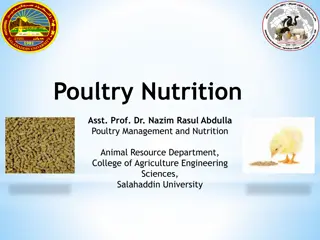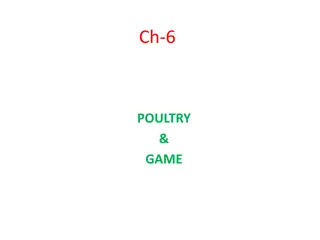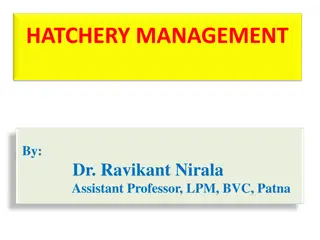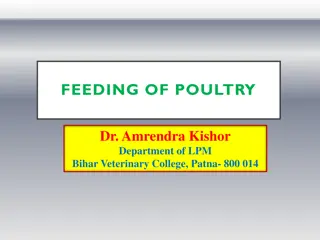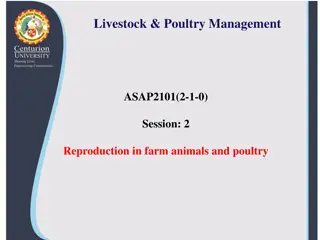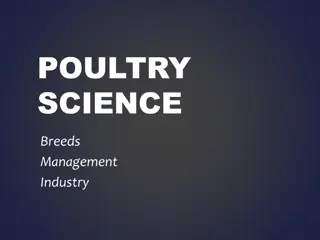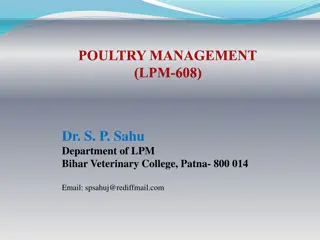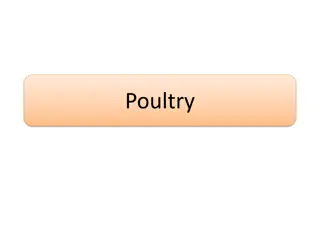Poultry Housing Management and System Overview
Poultry housing management is crucial for maintaining bird health and performance. Dr. S. P. Sahu discusses the importance of providing a suitable environment for poultry, including the impact of environmental factors like dust and gases. The different housing systems for poultry - free-range, semi-intensive, and intensive systems - are explained, highlighting their advantages and disadvantages in terms of disease risk, cost, land use, and bird protection.
Download Presentation

Please find below an Image/Link to download the presentation.
The content on the website is provided AS IS for your information and personal use only. It may not be sold, licensed, or shared on other websites without obtaining consent from the author. Download presentation by click this link. If you encounter any issues during the download, it is possible that the publisher has removed the file from their server.
E N D
Presentation Transcript
Dr. S. P. Sahu Department of LPM Bihar Veterinary College, Patna- 800 014 Email: spsahuj@rediffmail.com
HOUSING MANAGEMENT OF POULTRY Poultry are warm-blooded and must have a satisfactory environment in order to maintain their body temperature. In extreme environments, birds must expend energy to maintain this core temperature by adjusting their feed intake.
Environment factors, especially respirable dust and high concentrations of noxious room gases can increase mortality and reduced performance. By contrast, in 1944, the mean mortality of broilers was approx. 17% whereas at the end of the 20th century, it was reduced to below 4%. Modern systems have been developed to automate the delivery of feed and water.
HOUSING SYSTEMS FOR POULTRY: 1. Free range/extensive system: In this system, birds are left loose on field to scavenge their feed on their own from range. Shelter is provided by temporary roofing. The fields are used on traditional basis in rearing birds after harvesting of crops. The level of capital and labour investment is low. The average stocking of birds is 250 per hectare. The advantages of this system are that little labour is needed and waste food can be used efficiently. The free-range system is most suitable when a lot of space is available and covered with grass.
Advantages : 1. Maintenance on clean ground decrease the risk of disease. 2. Reduction in cost of management. 3. Birds get good amount of feed from the land 4. Cost of housing is less. 5. Soil fertility is maintained Disadvantages: 1. Losses are serious where predatory animals are abundant 2. Wild birds may consume much feed and they transmit disease. 3. Eggs may be lost when laid in hedge rows. 4. Impossible for adoption unless ample land is available.
2. Semi intensive system: Birds are housed on solid floor portable houses and they are given also the access to run. The maximum stocking rate is 750 birds per hectare. The success of the system depends upon the condition of the run to reduce the contamination. Advantages: 1. Complete control over operation 2. Useful for record purposes 3. Operational throughout the year 4. Economic use of land 5. Better protection during winter Disadvantages: 1. High cost in fencing 2. Danger of over stocking
3. Intensive system: In this system, birds are completely confined to houses with bedding material on floor or on wire netting in cages. It is preferred for modern and commercial poultry production for specialised breeds. Intensive chicken farms require more investment of both capital and labour. Flock sizes in intensive production are normally in the thousands.
A. Deep Litter System: Birds are raised within four walls, over litter material which is of organic in nature, capable of absorbing moisture and releasing moisture to the atmosphere and also to serve as a bedding material for the birds. Some litter materials used are Saw dust, Coir pith, Paddy husk, Ground Nut, Wood shavings, straw chopping, paper straw chopping, sugarcane bagasse etc.
When moisture is absorbed there will be controlled microbial activity and odour will also be minimum. Vit. B12 and B2 are available. Depth 5 inches at beginning and 7-9 inches later. Qualities of good liter material: Readily absorb moisture, not cause injury to birds, Moisture level 25-30%, get decomposed and form good manure, spread evenly, non-toxic, and not cause dust pollution.
Advantages of deep litter system: 1. Land requirement is minimum 2. Easy and economic management 3. Scientific feeding and management 4. High degree of supervision. 5. Minimum Labour. 6. Automation is possible. 7. Manurial value is increased.
Disadvantages: If the management is bad, liberation and accumulation of ammonia, wet litter problem, dirty eggs, disease problems may result. Because of the direct contact between bird and litter, bacterial and parasitic disease may be a problem. Respiratory problems may emerge due to dust from the litter. The cost of litter is an additional expenditure on production cost.
B. Cage/Battery system: About 75 per cent of all the commercial layers in the world are kept in cages. Brooding cages are usually for young chicks and growing birds and are about 14 to 16 inches in height with 22 inches wide and 24 inches deep. Very popular, called as Californian cage system. Birds are kept under total confinement with minimum space feed and water provided from outside. Eggs laid will get rolled out by the inclined floor bottom.
Types of cages: 1. Single 2. Mutiples 3. Colony cages (20-30 birds). The width of the house must be determined by the dimensions of the cages. In mild climates, little housing may be required, suitable roof with curtains on the sides. These curtains are to be used only during the first few weeks and during inclement weather conditions.
Double decking and triple decking increases the density of the birds in the house having ample ventilation. Brooding unit must be away from the other birds. All-in all-out system of the rearing should be followed. With two decks or three decks cages, when the upper deck is not directly over the lower deck a sloping dropping tray is inserted between the decks.
Advantages: 1. Vertical expansion 2. Easy feeding and management. 3. Protection from Vermin and wild birds. 4. Litter borne diseases are avoided 5. Spreading of disease minimum 6. Minimum area is required / bird: Single- 1 sq.ft./bird, Multiple-0.75 sq.ft./bird and Colony 0.5 sq.ft./bird
Advantages .. 7. Cleaner eggs. 8. Research data collection easier 9. Identification, handling and culling of non-layers easier. 10. Insects and pests controlled 11. Vices are kept at minimum 12. Birds are of softer flesh than the floor reared birds. Disadvantages: 1. High cost of installation 2. Breeding is not possible except AI. 3. Cage layer fatigue or paralysis or fatty liver syndrome.
Points to be considered while constructing a poultry house 1. Location of poultry house: For the location of the poultry house, following points should be considered: Poultry house should be located away from residential and industrial area. Poultry house should be located in an elevated area and there should not be any water-logging.
Demand for the poultry products in the local market. Availability of poultry feed stuffs in the local market. Connectivity of a place by railway or road. Availability of cheap land, labours etc. Availability of facilities such as water and electricity supply. The disposal pit and sick room should be constructed only at the extreme end of the site.
2. Size : The construction cost per square feet is low with large sized pens as compared to small sized ones. Hence, it will be more economical to have large sized pens. 3. Types: There may be different types of houses for different agegroups: Brooder house for 0-6 weeks chicks, rearing/growing house for pullets (8-20 weeks) and Laying house. However, on a commercial farm there may be only one type of pens, where the chicks may be reared and also the laying birds are kept.
The type of house roofs are shed type, gable type, A type and plain type roof. 4. Direction: The long axis of the house should always be East to West. In hot and humid climatic region, it should always be in the path of sun to reduce exposure of sunlight inside the shed.
Housing management Design Poultry should be provided with a good housing which will facilitate: 1. Shelter 2. Protection from wild animals 3. Bad weather condition. Ideal housing helps the birds to perform well. To establish a viable poultry enterprise capital, land, labour and technical know-how are essential.
Housing management Design . The housing design should be flexible and it depends on: 1. Age and stage of the birds. 2. Functional requirement. 3. The climate and environment. 4. For efficient supervision 5. Minimum structures to have efficiency. 6. Economy in construction.
Requirements of housing for poultry Temperature: The optimum temperature in a poultry house is 650F (55 -750F). The greatest housing problem in India: High temperature prevails over a major portion of the country in a greater part of year. The hilly areas: Low temperature problem. Environmental factors such as direct sun light, heat radiated from the roof, heat radiated from the nearby soil are of great importance and should be considered while planning a poultry house.
Requirements of housing for poultry The roof should be made up of the proper material and of proper height with sufficient overhang. If the height is more, it will remain too cold in the winter months, but when it is too low, the radiation hazards will be very serious. Tall shady trees and grass around the house to protect t from the direct sun light and its radiation.
In summer, water sprinkled over the roof of the house during the afternoon to have cooling effect by evaporation of water. During the winter, efforts are to be made to provide the warmth. Seal the house from three sides using gunny bags, one side opposite the direction of the cold winds should be kept open for ventilation.
Light: It may affect the growth rate and reproduction. Light enhances the feed intake by increasing the feeding hours and hence the growth. The effect of light on maturity and reproduction has definite physiological basis. Light falling on the eyes of the birds produces stimulus which in turn affects the release of gonadotropin releasing hormones (LH and FSH). Light of white or yellow colour is quite effective. Red light has been recommended in brooder house for the control of cannibalism.
Floor space: After 20th week of age, the floor space provided @ 2.5 3 sq. ft. per bird for light breeds like White Leghorn. Floor space for heavy breeds should be 3 3.5 sq. ft. per bird (English and American breed). Feeding space: Feeding space required is 4 5 linear inch per bird. Watering space : It may be given @ 1 linear inch per adult bird Perching space : It is very important that perches are provided in the laying pens, so that the birds may settle during night time without being disturbed by other birds. This will be provided @ 8- 10 linear inches per bird.
Construction details of poultry houses Foundation around three feet deep from the ground level. The width on the bottom may be around 2.5 ft. and gradually reduced to 1 foot near the surface (at top). The plinth/table: 1 ft. height so that the pen can be easily drained. The side walls: 2 feet height with a width of 1 foot.
Construction details of poultry houses Thatched roof may cost less in the beginning but it need regular replacement and is not clean and cheap in long run. If galvanized iron sheets are to be used, they should be painted white on the upper side so that most of the heat is reflected back. The height of the roof neither be too less nor too high with overhag of 2.5-3 feet. Door for each pen: 3 x 5 feet for easy feed and water supply. Concrete or cemented rat proof floor.
Environmentally controlled houses for poultry A controlled-environment house (ECH) is one in which inside conditions are maintained as near as possible to the birds optimum requirements. It necessitates a completely enclosed insulated house with no windows. Air is removed from the house by exhaust fans and fresh air is brought in through intake openings.
Environmentally controlled houses for poultry Artificial light is used to illuminate the interior. The heat from the birds is used to keep inside temperature within the range required. It should have a good foundation and a gable roof. Air must be moved to replenish the oxygen, to remove moisture and ammonia and to keep an optimum temperature. Amount of air exhausted should be slightly more than the amount of air coming in to the building. A negative pressure is created within the building and is regulated by the exhaust system.
POULTRY LITTER MANAGEMENT Litter is defined as the combination of bedding material, excreta, feathers, wasted feed and wasted water. Absorbs excess moisture from the droppings and drinkers and promotes drying by increasing the surface area of the house floor. Dilutes fecal material, thus reducing contact between birds and manure. Insulates chicks from the cooling effects of the ground and provides a protective cushion between the birds and the floor.
Bedding material: High moisture absorption, light weight, inexpensive and non-toxic. Sawdust is currently the most popular bedding materials. Others are rice husk, wood shavings, chaffed straws, shredded papers etc. The quality of the in-house environment is highly dependent upon litter quality. The litter environment is ideal for bacterial proliferation and ammonia production.
Two factors that influence litter conditions are manure and moisture. The manure portion is largely out of a grower s control; however, growers can and must control litter moisture. Excess moisture in the litter increases the incidence of breast blisters, skin burns, scabby areas, bruising, condemnations and downgrades. The wet litter promotes the proliferation of pathogenic bacteria and molds; and ammonia production.
Prolonged exposure to high levels of ammonia (50-100 ppm) can result in kerato-conjunctivitis (blindness). Obviously, when ammonia levels are high enough to blind birds, production is seriously affected. Ammonia levels of just 25 ppm have been found to depress growth and increase feed conversion in broilers.
Litter that is too dry and dusty: Dehydration of new chicks, respiratory disease and increased condemnations. Ideally, litter moisture should be maintained between 25-30%. A good rule of thumb in estimating litter moisture content is to squeeze a handful of litter. If it adheres tightly and remains in a ball, it is too wet. If it adheres slightly, it has the proper moisture content. If it will not adhere at all, it may be too dry.
LITTER MANAGEMENT 1. Ammonia control: Most important during the first 14-21 days of the bird s life, with the first 7 days being the most critical when chicks are most susceptible to ammonia damage. Birds exposed to ammonia during brooding have decreased resistance to RD and more difficulty in clearing E. coli from the respiratory tract and one forth kg lighter in weight.
The optimal ammonia level target is 25 ppm or less at all times to help fight off respiratory disease challenges and prevent weight loss. Proper application of poultry litter treatment, adequate ventilation, lower density of birds and no re-use of poultry litter help to maintain acceptable ammonia levels in the poultry houses. 50-75 ppm of ammonia can reduce feed consumption, growth rate and carcass quality.
2. Moisture and Relative Humidity control: Moisture levels should not exceed 25-30% and RH% be managed constantly between 50-70%. Excessive moisture in broiler litter can cause litter caking, most commonly seen around drinker lines, sidewalls and corners. Wet litter does not retain heat well, so it can lower bird s body temperature which can be detrimental to weight gain, feed conversion and immune function.
Wet litter with high ammonia concentrations increases the incidents of paw lesions and fungal growth. Preheat houses 48-96 hours prior to bird placement to dry the bedding, purge ammonia and warm the floor. Keep litter depth at about 5-8 inches for sufficient moisture absorbing capacity. Litter less than five inches deep often has excessive caking.
3. Ventilation: Proper house ventilation is most basic means to maintain good litter quality and proper poultry litter management. Maintaining the equilibrium between ammonia concentrations, relative humidity, litter quality and the fuel costs associated with ventilation and heating is a delicate process. If any one variable becomes unbalanced, bird performance and profitability can be negatively impacted.
With proper chicken house ventilation, cake will only form along water lines. Use fans to move warmer air from the ceiling to floor during cold months, which will promote litter drying. Run adequate heat, ventilation and fan time to keep the relative humidity between 50-70% to prevent caking.
4. De-caking: Anywhere excessive moisture is present, litter caking occurs. The key to proper poultry bedding de-caking is to only remove the layer of cake in each house while conserving the litter base below to release moisture and ammonia. only remove the cake but don t disturb the good litter underneath. Level litter where cake removed to allow for a uniform height adjustment of water lines and feeders.
The best tool to level litter and minimize litter disturbance is to use a piece of chain link fence with the weight of a log or blocks attached to the upper side and drag lightly. Immediately close the house back up until further work is needed and restore minimum ventilation. This maintains floor temperature for the next flock while the excess moisture and ammonia is purged from the poultry bedding.
5. Litter Ecology: Litter ecology is a complex blend of microorganisms for an ever- changing environment. The litter in poultry house is a living organism. High humidity, warm temperatures and high pH favor the proliferation of pathogens in the litter. Avian influenza, Laryngo-tracheitis, Gangrenous dermatitis, Gumboro, Reovirus, Bronchitis and Botulism are the more serious viral and bacterial diseases to spread easily in contaminated litter.
Fungi that produce Mycoses or Mycotoxicoses may cause increased mortality when flocks are reared on reused litter. Parasites, such as round worms, tapeworms and coccidia are also a potential problem in reused litter. Wet litter further aggravates coccidiosis by providing the proper environment for oocysts to sporulate.
POULTRY LITTER PRODUCTION The quantity of poultry litter produced in a broiler unit depends on the litter management and feed intake and its digestibility. Broiler chickens generally digest 85-90% (87.50%) of the dry matter of the feed. Broiler chickens consume 2.5-3.0 kg of dry matter upto 35 days of age and 5-6 kg of dry matter upto 49 days of age.
0.34 and 0.63 kg of solid (DM) is excreted by a 35 and 49 day old bird, respectively. Total manure production (Fresh): 4 and 6 kg for 35 and 49 days old birds, respectively. The average daily fresh manure production for broilers is about 43 kg/1000 kg live weight. Broiler chickens: 55% of the total N, 70% of the P and 80% of the K. Poultry litter production ranges from 0.7 to 2.0 tons/1000 broilers/flock.








